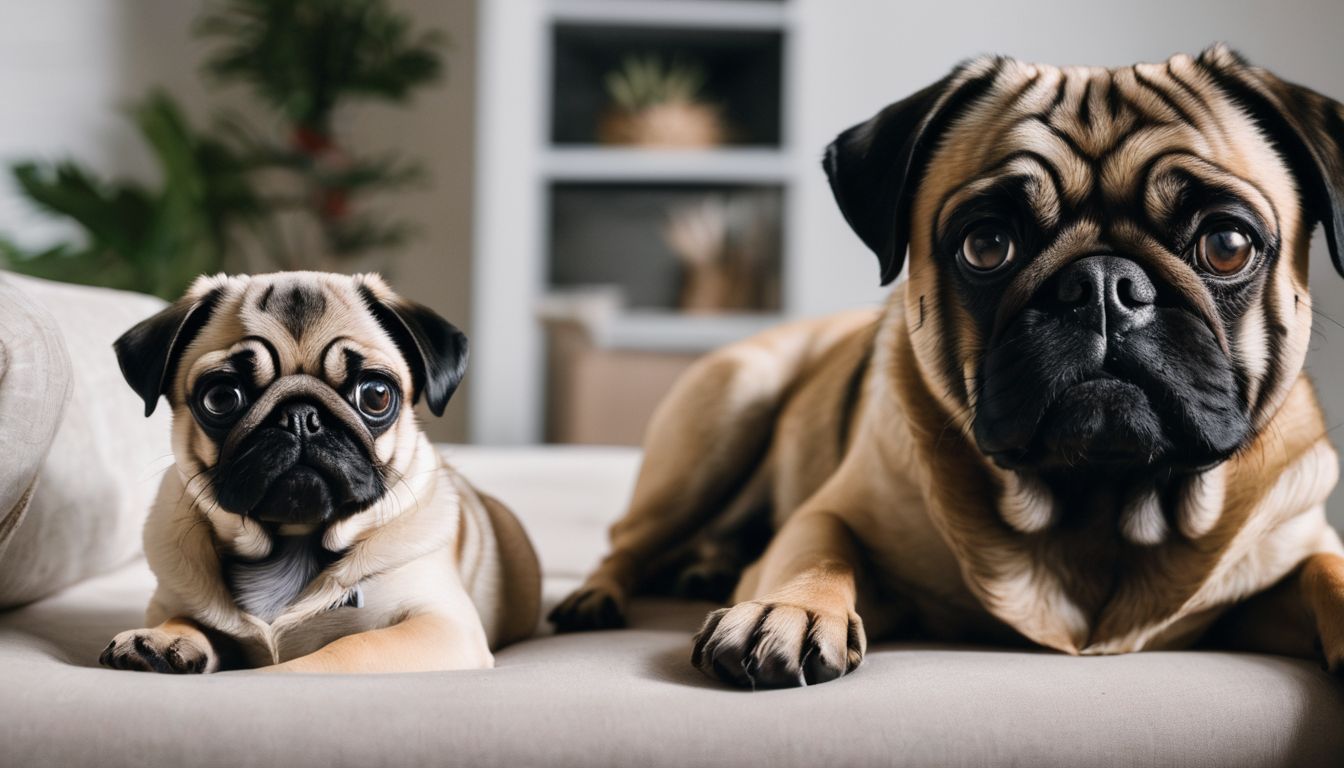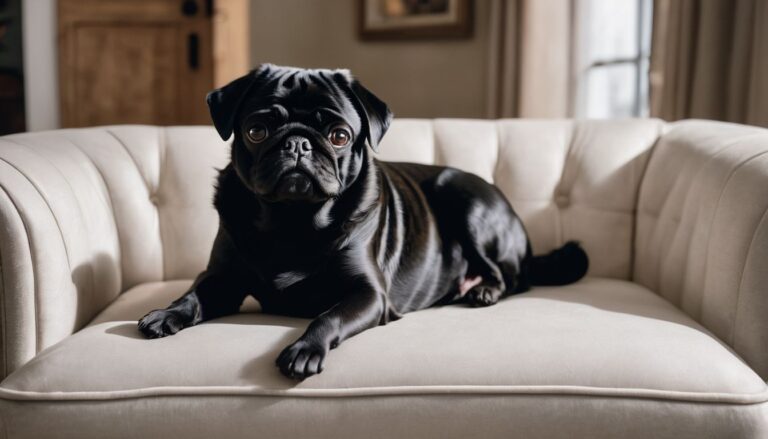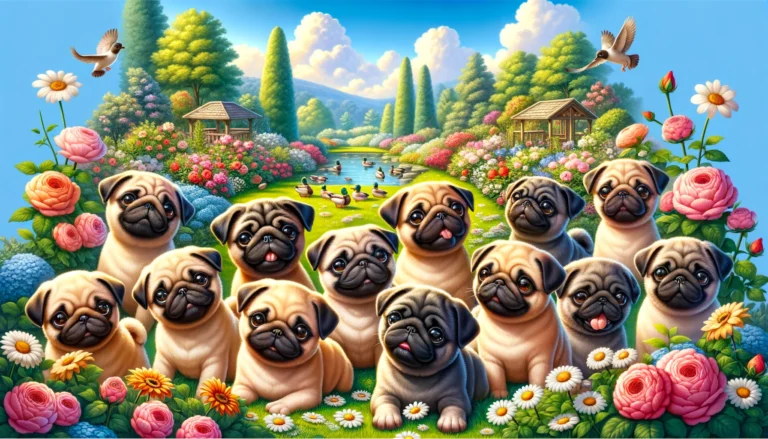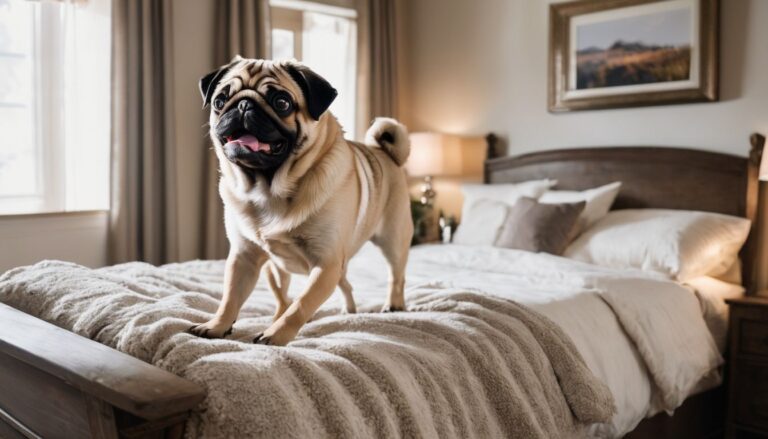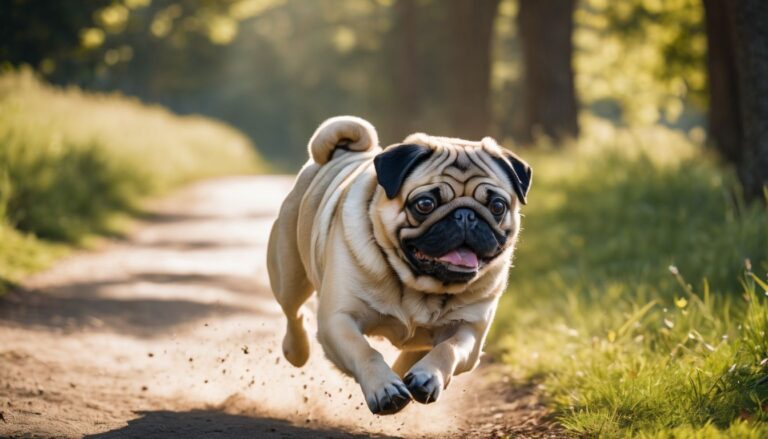Are Pugs Jealous Dogs? Exploring The Jealousy Tendencies Of Pugs.
Are Pugs Jealous Dogs?
Have you ever caught your pug looking a little down or out of sorts when new folks or furry pals enter the scene? It’s something quite a few of us have marvelled at, scratching our heads as we consider what’s going on in the minds of our pint-sized pets.
Research backs up these observations, indicating that Pugs often display attention-seeking antics more than other breeds – which might just shed light on those occasional flashes of jealousy.
Our article delves into this quirky behavior, uncovering reasons why your pug may be eyeing you with a touch of envy and offering strategies to keep their emotional well-being balanced.
Packed with insights, it’s designed to support harmonious living for you and your lovable four-legged companion—so let’s get started!
Key Takeaways
- Pugs have a strong desire for attention and can become jealous when not the center of it, often displaying signs like nudging with their noses or trying to come between their owner and others.
- Addressing jealousy in pugs requires timely intervention such as providing equal affection to all pets, training using positive reinforcement, and creating a secure space for them.
- Preventing jealousy from developing is important; this involves establishing routines that ensure individual attention, separating feeding times for multiple pets, and maintaining control during walks with leashes.
- Jealousy in pugs isn’t just about seeking more cuddles; it’s an emotional response that can be triggered by changes in routine, new family members or pets entering the home, or even owners being occupied with household tasks or technology.
- Consistent training sessions are vital for managing pug behavior. Basic commands help focus a jealous pug’s energy positively while socialization reduces potential envy towards newcomers.
Understanding Pug Jealousy

At the heart of a Pug’s charm is their deep-seated desire for companionship, but this can sometimes manifest as jealousy when they’re not the center of attention. We, as devoted Pug lovers, need to recognize and empathize with these emotions to foster a harmonious bond between us and our furry friends.
What causes jealousy in Pugs
Jealousy in Pugs often stems from their deep loyalty and need for affection. These companion dogs form strong attachments to their owners, craving attention and interaction. They place immense value on the time spent with people they consider part of their family.
When a Pug feels that another pet or person is taking away their special moments with you, this can trigger feelings of jealousy. Whether it’s cuddling on the couch or playing in the home, Pugs want to be at the heart of it all.
Our beloved pugs rank quite high in seeking our undivided focus, indicating a natural inclination towards envy when overlooked. Competition for resources like dog food, treats, or toys can also spark jealous behavior among pugs; imagine watching someone else enjoy what they believe should be theirs! It’s important we understand these triggers so we can preemptively address any potential issues without causing our furry friends undue stress or anxiety.
Let’s ensure we’re providing consistent training and equal love to keep our loyal companions happy and harmonious in our households.
Pugs as a loyal and sensitive breed
Pugs have earned a reputation for their unwavering loyalty and sensitivity towards their owners. They form deep bonds with their human families, often shadowing them from room to room, always eager for interaction and affection.
This inherent loyalty stems from a genuine love for companionship which can be both endearing and demanding. Their sensitive nature means they are quick to pick up on changes in our tone of voice or body language, responding with expressive faces that reflect concern or happiness right alongside us.
Their devotion also makes pugs ideal pets for those who appreciate a dog that truly becomes a part of the family. But this same trait can lead them down the path of jealousy if they sense they’re not getting enough attention.
Ranked 24th out of 124 breeds when it comes to seeking attention, these charming dogs have an instinctive need to feel included and loved by their people. As owners, we play a crucial role in managing their emotional well-being by ensuring they receive the regular care, interaction, and affirmation that such a loyal breed deserves.
The role of human companionship in Pug jealousy
Human companionship plays a significant role in the emotional well-being of our Pugs. These loving dogs thrive on the affection and attention we give them, which can sometimes set the stage for jealousy.
Our closeness with these canine pals can cause them to demand more attention when they sense competition, whether it’s from another pet or even a new baby in the household. They might exhibit this by getting between us and whatever is drawing our focus away from them.
Our efforts to understand and manage their jealous behaviors are crucial. We show commitment to our furry friends not just through ear scratches and playtime but also by recognizing signs of unrest before they escalate.
This proactive approach leads us into looking at other cues that indicate jealousy, transitioning smoothly into ways we can identify such emotions in our devoted Pugs.
Are Pugs Jealous Dogs – Signs to Look Out For
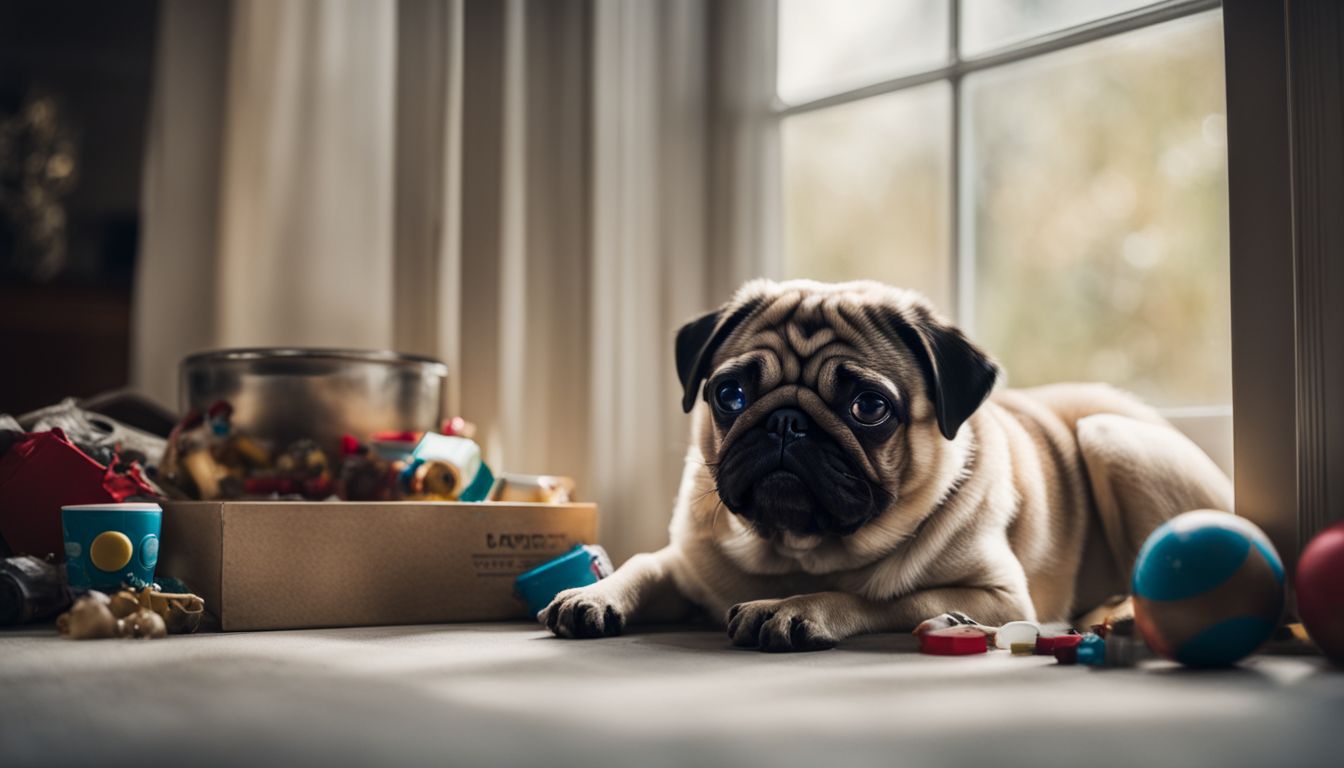
Recognizing when your beloved pug is feeling jealous can be crucial to maintaining a harmonious household. Keep an eye out for subtle shifts in their demeanor or actions that signal they’re vying for your undivided attention and affection.
Body language and behavior cues
Pugs often communicate their feelings through body language and behavior cues. As pug lovers, we know it’s crucial to understand these signals to maintain a happy and healthy relationship with our furry companions.
- Pugs might push or touch their owners with their noses when they feel jealous. This action is a way for them to seek attention and tell us that they want to be the center of our world.
- A clear sign of jealousy is when your pug tries to get between you and another pet or person. They may physically place themselves in your lap or in front of you, acting as a barrier.
- Snapping at other pets or people can also indicate that your pug feels threatened by someone else receiving your affection. It’s important to monitor this behavior closely as it can lead to aggression if not addressed.
- You might notice increased barking from your pug in situations where they are not the focus. This vocalization is an attempt to redirect your attention back onto them.
- Licking excessively can be another indication of jealousy. Pugs sometimes use licking as a way to soothe themselves or as an attempt to show affection and regain your attention.
- Watch for changes in posture; a stiffened body or raised hackles can signal that your pug is feeling anxious or upset over potential competition for your love.
- Pay attention if your pug follows you more than usual, especially if they seem insistent on staying close by; it may be a bid for reassurance of their special bond with you.
- Your pug might display herding tendencies similar to herding dogs, trying to control where you go and who you interact with, born out of a desire not to share you with others.
Examples of jealousy triggers
Jealousy can sneak up on pug owners, sometimes catching us by surprise. Our adorable pugs may feel left out when not the center of our world.
Here are some scenarios that can trigger jealousy in these sensitive companions:
- Bringing a new pet into the home: Pugs might get jealous if a new animal, especially another dog, comes into their space and starts getting attention.
- Showing affection to someone else: Whether it’s cuddling a child or hugging a friend, pugs may react if they see their favorite person giving love to others.
- Changes in routine: Sudden alterations in daily activities or spending less time with your pug can make them feel insecure, leading to jealous behavior.
- Ignoring them for household tasks: When we’re busy doing chores and not paying attention to our pugs, they might feel neglected and act out.
- New people visiting the house: The presence of guests can make pugs anxious about their place in the social hierarchy, resulting in acts of jealousy.
- Spending time with technological devices: Prolonged periods on the phone or computer may lead our pugs to believe they’re competing with these gadgets for our affection.
Coping with Pug Jealousy
Navigating the complex emotions of our Pug companions requires sensitivity and understanding; when jealousy arises, it’s crucial to address these feelings head-on through practical strategies.
By adopting a proactive approach, we can foster harmony and strengthen the bond between ourselves and our beloved furry friends.
Addressing jealousy ASAP
As soon as we notice our Pug showing signs of jealousy, it’s crucial to step in right away. Quick intervention prevents these behaviors from turning into habits that can disrupt the peace at home.
Our loyal and affectionate companions need to understand that love isn’t a resource that runs out – there’s enough for everyone.
We must provide consistent training, using positive reinforcement to foster an environment where our Pugs feel secure. It’s essential to distribute attention evenly, particularly when new pets or family members enter the picture.
By addressing jealousy immediately with clear guidance and patience, we ensure a happy balance for all our beloved furry friends.
Equal attention and affection for all pets
Ensuring every pet feels cherished is crucial, especially in a household with more than one furry friend. If we have multiple pets along with our pug, we must spread our love evenly to prevent jealousy.
Pugs are known for their strong bonds and can become envious if they sense another animal is receiving more attention. We should allocate time each day to play with our pug, cuddle them, and engage in activities they enjoy alongside caring equally for other pets.
Maintaining a balance of affection requires conscious effort but pays off by fostering a peaceful environment at home. It’s essential that during family activities everyone gets included; whether it’s setting aside moments for group play or individual snuggle sessions, these actions reinforce the idea that there’s enough love to go around.
This approach not only mitigates feelings of resentment among pets but also strengthens the emotional connection we share with each of them, ensuring no tail wags less just because another wags more.
Creating a safe space for your Pug
Creating a safe space for your Pug is crucial to help curb their jealousy. We often use crate training as a trusted method to provide our furry friends with a secure and cozy area that they can call their own.
Inside their special spot, Pugs can retreat when the world feels overwhelming or when they just need some quiet time away from potential rivals. Fill the crate with comfortable bedding, favorite toys, and even an item that smells like you to reinforce the bond and sense of security.
To maintain peace in multi-pet households, especially since Pugs rank noticeably high for attention-seeking behaviors, it’s important we establish separate zones for each pet. This approach helps our pugs understand there’s enough love to go around and minimizes competitive behavior over territory or owner affection.
Separating meal times for pets
Just as providing a safe haven for our Pugs is key to their well-being, so is managing their meal times, particularly when multiple pets share the same home. Feeding them separately can prevent any feelings of competition that might lead to jealousy.
- Schedule individual feeding times for each pet. This ensures your Pug gets its fair share of food without feeling threatened by other animals.
- Use separate areas for each pet’s meals. It prevents your Pug from becoming territorial over its food and reduces tension among pets.
- Be consistent with the routine. Pets thrive on predictability, and a regular feeding schedule will help your Pug feel secure and less anxious.
- Monitor interactions during meal times initially. This helps in detecting any signs of stress or aggression early on, allowing you to intervene if necessary.
- Gradually introduce communal meal times if desired, once your Pug shows comfort with the arrangement. Start with short, supervised sessions to ensure all goes well.
- Consult a dog trainer for advice on positive reinforcement techniques that encourage calm behavior around food. Their expertise can be invaluable in maintaining peace at mealtimes.
Leashing all dogs on walks
For instance, if another dog approaches and your Pug feels like its territory or relationship with you is threatened, a leash provides control and reassurance to your dog, reducing the chance of competitive behavior.
We also ensure the safety of all involved by leashing our pups. It keeps them from running off after distractions – be those people, other animals, or cars – which could lead to dangerous encounters or accidents.
With their strong desire for attention and potential for jealousy as indicated in research on canine perception and behaviors, having your Pug on a leash during walks makes it easier to manage interactions and give consistent attention to help curb any feelings of neglect or rivalry they may experience.
Training your Pug
As we keep a close watch on our beloved pugs during walks, training becomes an equally important aspect of their care. Training your pug not only helps manage jealousy but also strengthens the bond between you and your furry friend.
Here are some practical steps to ensure effective training:
- Establish a routine for training sessions early on. Pugs respond well to consistency, so try to train at the same time each day.
- Use positive reinforcement techniques. Rewarding your pug with treats or praise when they follow a command encourages good behavior.
- Focus on basic commands first. Teach commands like “sit,” “stay,” and “come” before moving on to more advanced tricks.
- Keep training sessions short and fun. Pugs have short attention spans, so aim for 10 – 15 minute sessions that end on a positive note.
- Address jealousy head-on during training. If your pug shows signs of being jealous, such as snapping or pushing, redirect their attention with a command.
- Socialize your pug with other pets and people regularly. This reduces the likelihood of jealousy towards new individuals entering their space.
- Practice patience throughout the process. Training takes time, especially with stubborn breeds like pugs, but persistence pays off.
The Importance of Addressing Pug Jealousy
Pug jealousy isn’t just a small quirk; it’s a real issue that can affect the harmony in our homes. If we overlook their jealous behaviors, these situations can escalate and lead to stress for both our pugs and ourselves.
Tackling jealousy head-on helps maintain balance, ensuring all household members feel secure and loved. It tells our loyal pugs that they have a special place in our lives, which is crucial given their ranking as one of the breeds most prone to attention-seeking behaviors.
We need to be proactive about addressing signs of envy before they turn into bigger problems—like snapping at other pets or competing aggressively for affection. This approach safeguards the loving bond we share with our pugs, fostering an environment where peace reigns supreme.
With careful attention and care, we prevent potential discord from arising among furry companions or between children and pets within the family dynamic. Now let’s look at how we can prevent this jealousy from emerging in the first place with practical tips on keeping those wagging tails happy.
Tips on How to Prevent Pug Jealousy
Preventing jealousy in our pug dogs is vital to nurturing a loving and peaceful home. We must recognize their need for attention and work towards creating an environment that addresses it.
Here’s how we can help keep jealousy at bay:
- Establish a routine where each pet receives individual attention daily, reinforcing their bond with us.
- Offer equal affection and playtime to all of our pets to ensure no one feels left out or less favored.
- Create a special place for our pugs where they can retreat when feeling overwhelmed, giving them a sense of security.
- Separate feeding areas for multiple pets can prevent competition during meal times, reducing potential conflicts.
- Use leashes during walks to manage interactions between our pugs and other dogs, keeping control over social situations.
- Invest time in training sessions that focus on positive reinforcement, fostering good behavior while strengthening our relationship with them.
Are Pugs Jealous Dogs Conclusion
We’ve learned together that pugs can indeed show signs of jealousy, much like their human companions. They crave our love and attention, often reacting when they feel left out. Recognizing these emotions in our furry friends is key to strengthening the bond we share with them.
By understanding their need for affection and addressing any jealous behaviors promptly, we ensure a happy coexistence. Up next, let’s dive into some handy tips for preventing pug jealousy before it starts.
Are Pugs Jealous Dogs References and Further Reading
For those who want to dive deeper into understanding Pug jealousy and behavior, there are books and articles that can offer more insight. “Pugs: Grooming, Training, Health Problems” by Kay White provides a detailed look at the breed’s personality traits including their need for attention.
This resource is great for new and experienced Pug owners alike.
We also recommend exploring studies on canine emotions to get scientific perspectives on jealousy in dogs. You’ll find interesting research articles available online that discuss how breeds like Pugs show signs of being emotionally complex animals.
For more practical tips on dealing with jealous behaviors in your furry friend, check out resources like Amazon.com which have a range of pet care books focusing on training and managing multiple pets in one household.
Are Pugs Jealous Dogs FAQs
1. What makes pugs tend to be jealous?
Pugs can sometimes show signs of jealousy if they’re not getting enough attention or if they feel their special bond with their owner is being threatened by someone else.
2. How do I know if my pug is feeling jealous?
If your pug starts acting grouchy, barks more than usual, or tries to come between you and another person or pet, these could be clues that your pug might be feeling jealous.
3. Can retro pugs also show jealousy?
Yes, retro pugs, which are a result of crossbreeding to improve health issues in purebred pugs, can also display feelings of jealousy similar to regular pugs.
4. What should I do if my retro pug shows signs of jealousy?
It’s important to ensure your retro pug gets plenty of love and personal time with you. Also, train them gently to understand it’s okay when other people or pets are around you too.

